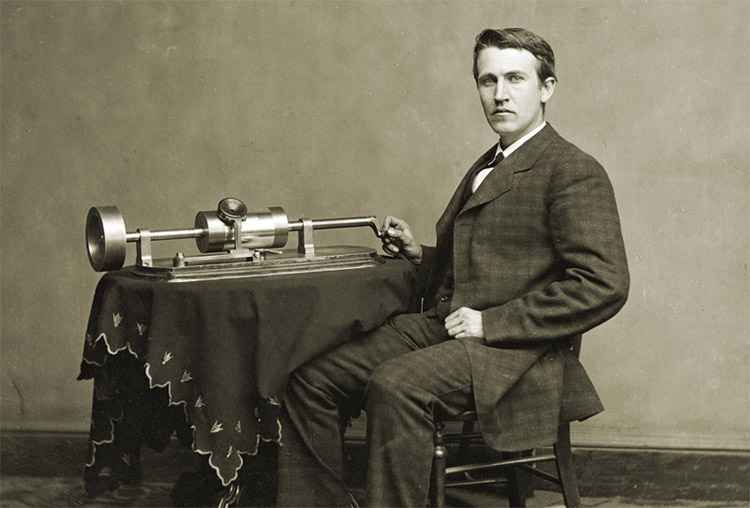Why
December 6?
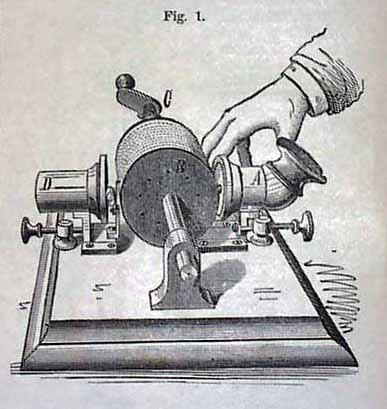
The
Birthday of the Phonograph is December 6, 1877

Why
December 6th?
Friends
of the Phonograph
celebrate the Phonograph's birthday
on December 6 to mark the completion of Edison's Phonograph
and the decision by Edison that his invention was ready to be
heard by the public.
FACTOLA:
On December
4, 1877, Charles Batchelor, one of Edison's aids, recorded in
his diary "Kruesi made the phonograph today." Edison
Cylinder Records 1889 - 1912 With an Illustrated History
of the Phonograph, Allen Koenigsberg, APM Press ©1987.
p. xii.
FACTOLA:
On
December 6, 1877, Charles Batchelor
"recorded in his diary "Kruesi finished the phonograph." Ibid.
FACTOLA: On December 7,
1877 Edison's infant invention was taken to the office of Scientific
American where the Phonograph introduced itself. (See Note:
2 for more details about this date). This public
debut of the machine which Edison would later call his "favorite
invention" and his "baby"(2A),
was subsequently described in the December 22, 1877 issue of
Scientific American. The Papers of Thomas A. Edison, Vol.
3, The Johns Hopkins University Press, Baltimore, ©1994,
p. 659.
FACTOLA: On December 7,
1877 The Kruesi patent model (wood) was completed. The work
sheet for it survives and is illustrated in "Edison Cylinder
Records 1889 - 1912," Allen Koenigsberg, 2nd edition 1987.
The original patent model is in the Collections of The Henry
Ford at Dearborn, Michigan. See Kruesi
patent model Endnote for details.
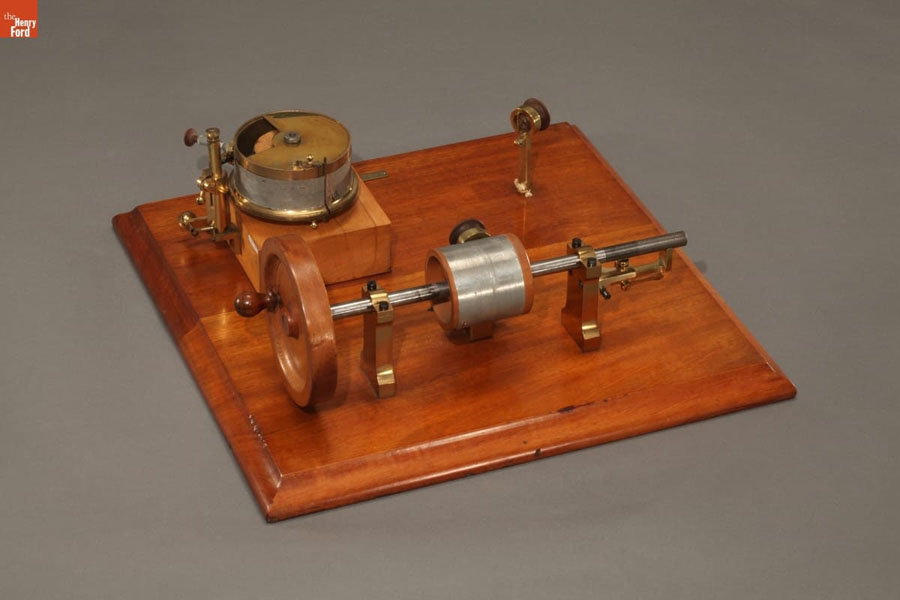
Patent Model for
Edison's 1877 Tinfoil Phonograph (From the Collections
of The Henry Ford. Gift of the Edison Pioneers.)
The
Phonograph's Birthday Timeline
Edison's phonograph timeline includes
dates leading up to its 'birth'.
The following are dates related
to the capture and study of sound waves, conception of recording
and reproducing sound, telephone related experiments, the Edison
phonograph's construction, testing and word(s) 'first' spoken
and repeated back, patent filing, and phonograph demonstrations.
For an overview of the history of
recorded sound see "The
Birth of the Recording Industry" by Allen Koenigsberg
©1990.
March 25, 1857 - Édouard-Léon
Scott patented his Phonautograph. The phonautograph is the earliest
known device for recording sound. At the time it was not the intention
of Scott to reproduce sound but rather to study what sound waves
looked like and potentially transcribe.
April 9, 1860 - The
first line of "Au clair de la lune" was recorded by
Édouard-Léon Scott on his Phonautograph. These recorded words
were at one point called "the earliest
clearly recognizable record of the human voice yet recovered"
(although these words were not actually heard until 2008 with
the help of computer technology). Since then "even older
recordings" have been "identified and played back."
See FirstSounds.org
for the most current information and access to "humanity's
earliest sound recordings."
April 30, 1877 - Charles
Cros submits a sealed envelope containing a letter to the Academy
of Sciences in Paris explaining his proposed method for recording
and reproducing sound. Although this envelope was not opened until
December 3, 1877, Cros should, at minimum, be credited "with
anticipating, though barely, what Edison was to accomplish"
(12) and describing an
invention which he named the Paleophone (voix du passé).
July 17, 1877 - The Speaking
Telegraph - Edison Lab Notes (3) reads: "Glorious = Telephone
perfected this morning 5 am = articulation perfect -- got 1/4
column newspaper every word. -- had ricketty transmitter at that
-- we are making it solid." (Note: The Philadelphia Inquirer
for Tuesday, July 17,1877, ran an article describing the rehearsal
at the Permanent Exhibition).
Phonograph historian Patrick Feaster
notes that on this date "Edison and his associates sketched
out the principle of phonographic sound" (4).
July 18, 1877 - Edison "announces"
his intention to invent the phonograph.
(5)
The Thomas A. Edison Papers Project
describes the July conception of the future Phonograph as follows
(6):
In July 1877, while
developing his telephone transmitter, Edison conceived the idea
of recording and playing back telephone messages. After experimenting
with a telephone "diaphragm having an embossing point & held against
paraffin paper moving rapidly," he found that the sound "vibrations
are indented nicely" and concluded "there's no doubt that I shall
be able to store up & reproduce automatically at any future time
the human voice perfectly." Edison periodically returned to this
idea, and by the end of November, he had developed a basic design.
End of July 1877
- Edison "constructed a paraffin paper device called a telephonic
repeater" which in the "course of many experiments thought
he could hear the sound of human voices or music when the strip
of paper moved quickly beneath the spring-driven point. Inspired,
he quickly yelled "Halloo" into the crude mouthpiece,
and was completely taken aback when the machine faintly imitated
him moments later. (7)
July 30, 1877 -
Edison filed a patent application in great Britain, No. 2,909, and
"disclosed not only a cylinder phonograph, but also an apparatus
embodying his original conception of an embossed strip." Thomas
Alva Edison - Sixty Years of an Inventor's Life by Francis Arthur
Jones, Hodder & Stoughton, London, 1907, p 244.
August 12, 1877
- The Library of Congress' website America's
Story assigns this as the "date popularly given for
Thomas Edison's completion of the model for the first phonograph.
(8). See reference 7 (above). See cover
below postmarked Edison, NJ August 12, 1977 (but not First Day
of Issue postmark).
November 29, 1877
- Basic sketch of the Phonograph completed that apparently was the
"sketch that his workman, John Kruesi, used to construct the
first tin-foil model." (9)
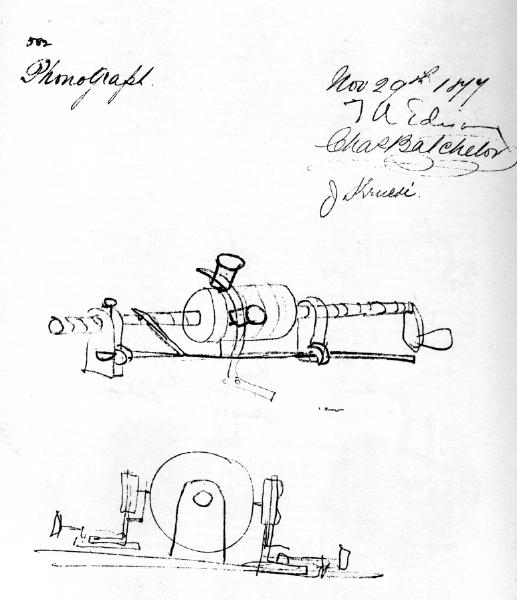
First sketch of the Phonograph -
November 29, 1877 (Edison Cylinder Records, 1889 - 1912 With
an Illustrated History of the Phonograph, Allen Koenigsberg,1987,
p. xiv).
December 3, 1877 - Experimenting
with different thickness of tin foil. Batchelor writes in the Technical
Note (signed by Chas. Batchelor, T. A. Edison and James Adams) titled
Phonograph Dec 3, 1877 "Have tried lot of experiments with
different thickness of tin foil. Its the best material yet for recording."
That conclusion by Batchelor indicates that sound is being recorded
and played back.
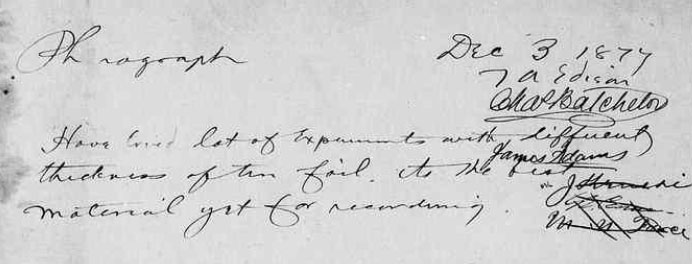
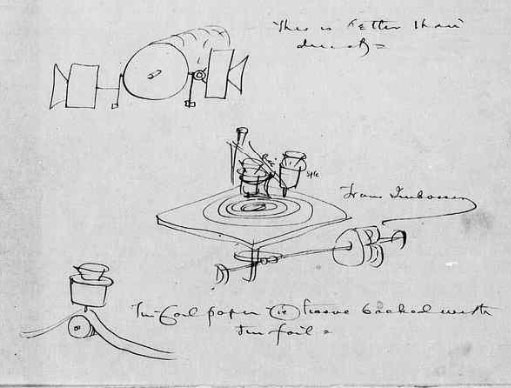
Provided by The
Thomas A. Edison Papers at Rutgers University [NV17021]
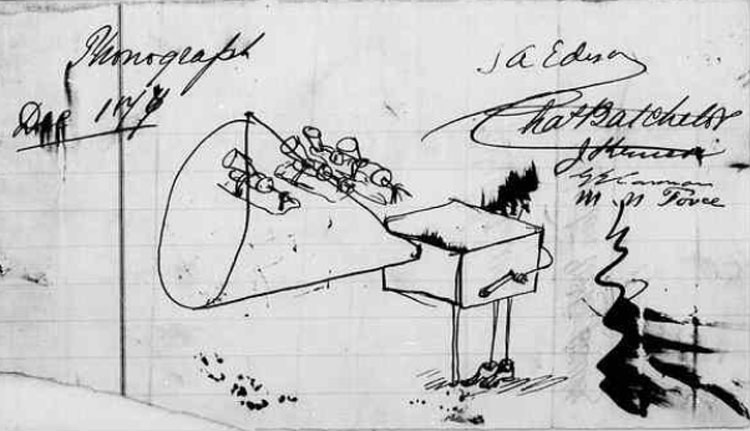
Editor's Notes for December
3 also included the "Organ grinder phonograph; illustration for
11/23 proposal for uses of phono."
December 4, 1877 - "Kruesi
made phonograph today." (10)
Testing is being done using the phonograph
that Kruesi has made on December 4 and it's documented that the
phrase "How do you get that" was recorded and repeated
back before Edison's December 6th reciting of "Mary had a Little
Lamb." The following Technical Note includes Batchelor commenting
that sound is being reproduced very well by the reproducing diaphragm
and includes a figure of the phonograph. Batchelor writes: "G
is the reproducing diaphragm which receives its vibrations from
spring H. This works well and the phrase "How do you get that"
comes very plainly. Chas. Batchelor."
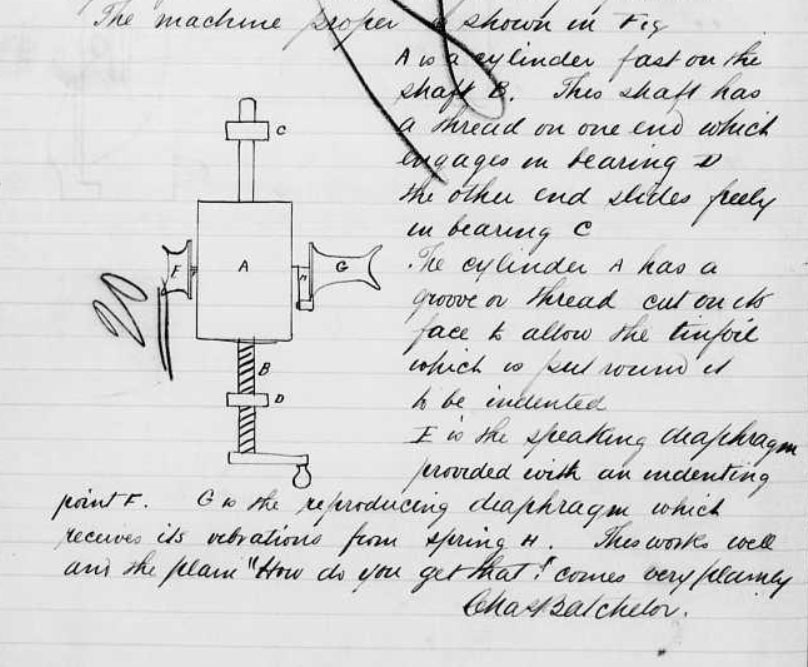
Provided by The Thomas
A. Edison Papers at Rutgers University [NV17021].
December 6, 1877 - "Kruesi
finished the phonograph." (1)
Kruesi finishing the phonograph meant
it was built and ready to be tested by Edison.
The Thomas A. Edison Papers Project
(11) describes the events
of December 6 as follows:
"When Kruesi finished making
the phonograph Edison put on the tin foil and then recorded the
nursery rhyme "Mary Had a Little Lamb"; Edison's daughter Marion
was at the time nearly five years old and his eldest son was almost
two. Edison then "adjusted the reproducer and the machine reproduced
it perfectly. I never was so taken back in my life. Everybody
was astonished. I was always afraid of things that worked the
first time."
The "How do you get that"
of December 4,1877 and other words that were spoken, recorded and
repeated back during the experimenting, building and testing of
the Kruesi tinfoil phonograph (prior to Edison's December 6 "Mary
had a Little Lamb") are certainly part of the phonograph's
development.
For Friends of the Phonograph,
however, words that were heard before December 6, 1877 are interpreted
as having taken place before Kruesi turned over his "finished"
work to Edison and while the Stork was still in route for the delivery
of Edison's "baby."(2)
Addressing December 6th as the phonograph's
birthday, Allen Koenigsberg, long-time phonograph collector and
publisher of The Antique Phonograph Monthly (1973-1993) liked
the December 6 birthday date but added some "twists."
In Allen's words "Certainly Dec 6th is better than the various
others that have floated during the last century. There are always
slight twists to these things, as didn't Batchelor give Dec 4, for
"How do you get that" as the first recorded words? (before "Mary").
On the other hand, there is (also) the 'Halloo Phonograph' (pre-cylinder)
of late July 1877, which looked like a flat slide-rule, and held
a small strip of paraffined paper (enough for one word anyway).
TAE refers to it in early Feb 1878." (1A)
In short, all three conditions are
met for the Phonograph's Birthday being on December 6 with its delivery
and birth completed on December 6: 1) Kruesi finished the
Phonograph on December 6; 2) Edison spoke and then heard what he
later said were his "first words into the original phonograph,
a little piece of practical poetry: Mary had a Little Lamb"
on December 6; and 3) Edison made the decision on December 6 that
his Phonograph was finished and ready to talk to the world which
he would do the next day by taking the phonograph to the office
of Scientific American where the precocious phonograph would
introduce itself.
December 7, 1877 - Phonograph
taken to offices of Scientific American by Thomas A. Edison,
Charles Batchelor, and Edward Johnson for its first public
demonstration.
On December 7 and with the Phonograph
1 day old, the Phonograph visited the office of Scientific American
in New York City where it would introduce itself and make remarks
that "were not only perfectly audible to ourselves, but to
a dozen or more persons gathered around."
The phonograph's demonstration resulted
in Scientific American's article "The
Talking Phonograph" which reported that Edison's "little
machine" was able to record the vibrations of the human voice
and, when played back, repeated what was "nothing else than
the human voice." Believing
that the Phonograph could have an "astonishing" future
they were also recognizing that the human perception of ephemeral
sound would never be the same when they wrote it "is impossible
to listen to the mechanical speech without his experiencing the
idea that his senses are deceiving him."
December 15, 1877 - Edison's
application for Phonograph patent executed.
December 22, 1877 - Scientific
American publishes story about Edison's Phonograph.
December 24, 1877 - Edison
patent for Phonograph filed.
February 19, 1878 - U.S. Patent
No. 200,521 granted for Edison's Phonograph.
April 18, 1878 - Edison in
Washington D.C. to demonstrate his Phonograph to the National Academy
of Sciences.
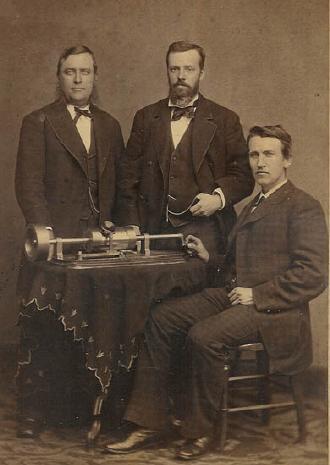
Thomas Edison seated with his "Brady"
tinfoil Phonograph, April 19, 1878 in the studio of Mathew Brady.
Standing left to right are
Uriah Painter and Charles Batchelor. Courtesy of the Edison National
Historic Site.
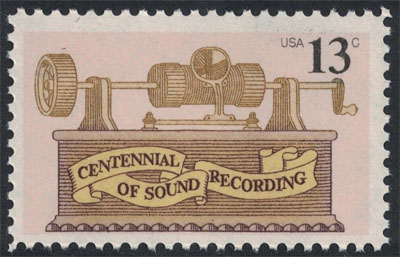
For examples of postage stamps issued
for the Centennial of Sound Recording and respective First
Day of Issue Covers (FDC), see Phonographia's Phonograph
First Day Covers and Stamps.
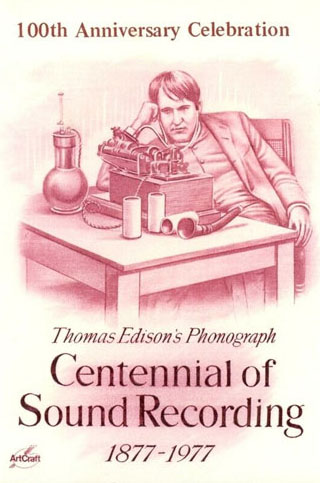
Special
thanks to Allen Koenigsberg, The Thomas Edison National Historical
Park, Rutgers School of Arts
and Sciences "Thomas A. Edison Papers,"
and the Henry Ford "Museum of American Innovation."
The 1898 Revisionist History by
the Columbia Phonograph Company for the Birth and Life of the Talking
Machine.
For the Revisionist History of the
invention of the first talking machine presented by Mr. J.
J. Fisher in 1898 see the following article from The
Phonoscope, December 1898.
J. J. Fisher recorded songs for the
Columbia Phonograph in 1898 and it was Fisher's recorded message
which was used as the opening address at the Waldorf-Astoria "to
present the case that the Columbia Phonograph Company's patented
"discovery that sounds could be recorded by a process of
engraving on a wax-like material" was what provided "the
life of the talking-machine art, which has no existence before it
was made and could not exist without it. In 1888, Mr. Edison borrowed
the discovery of Bell and Taintor and used it in an instrument to
which he gave the name borne by his absortive (sic ~ abortive?)
attempt of 1877....The credit for the original discovery belongs
to Bell and Taintor."
To emphasize the claim that Edison's
original "old tin-foil Phonograph was a mere toy of no practical
value and was very soon dropped by himself" (Edison) and
that "the life of the talking-machine art" belonged
to the lineage of the Columbia Phonograph Company, a Columbia Graphophone
Grand was used to provide the following recorded "address"
by Mr. J. J. Fisher. It was reported that "every word of Fisher's
recorded message was "clear, distinct and natural in tone."
Note: This article begins by describing
the context as "an exhibition of the Graphophone Grand"
so it was clearly a Columbia Phonograph Company sponsored event.
At the end of Fisher's recorded address it is further confirmed
by Fisher simply adding "that anyone desiring further information
on this fascinating subject can obtain it at either of the offices
of the Columbia Phonograph Company, whose numbers are on the pragram
(sic)."
It's also noteworthy when reading
this address to remember the on-going litigation that was
part of the phonograph's post-1888 history, particularly involving
Edison, Columbia and the Victor (Berliner) Companies.
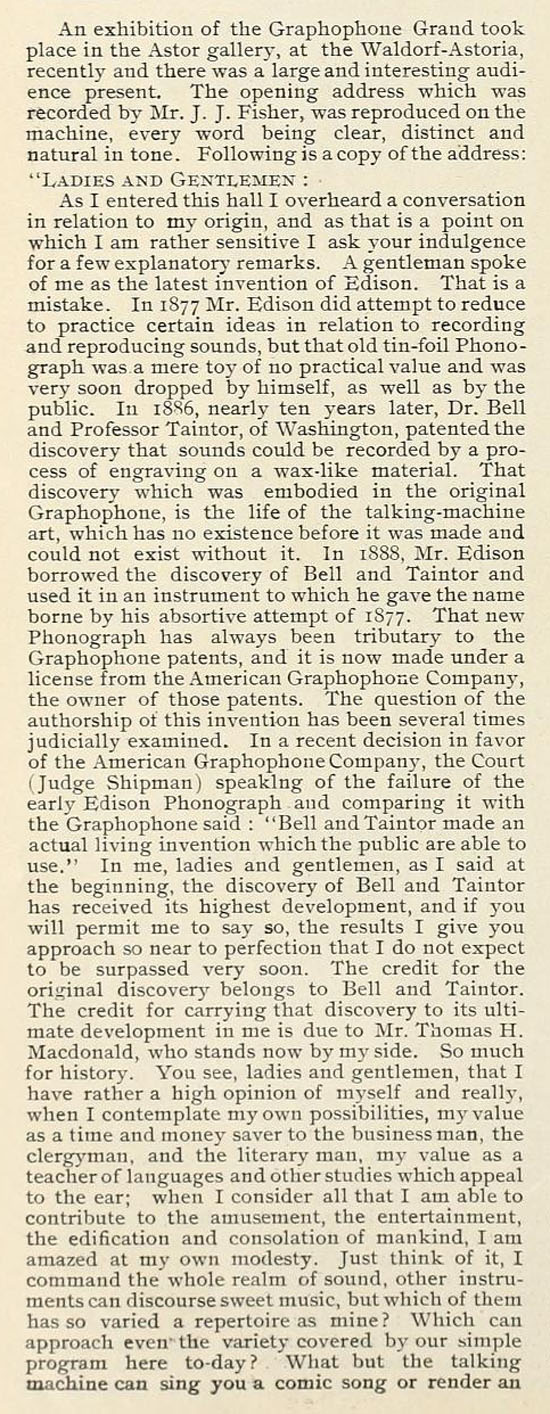
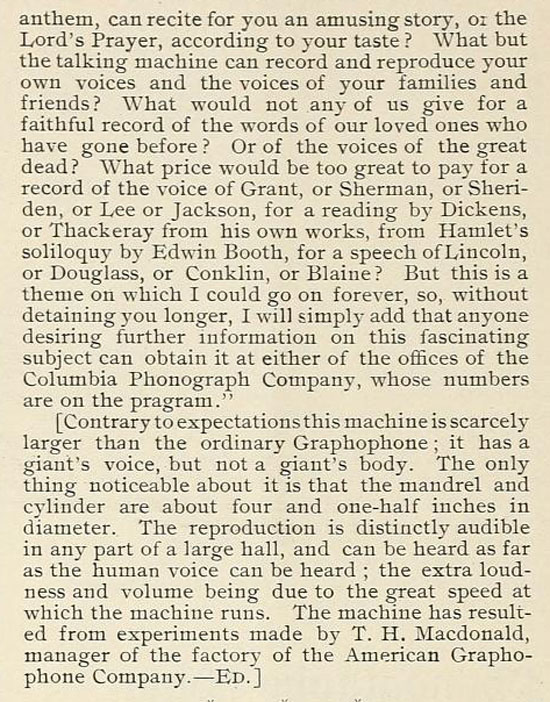
The
Phonoscope, December 1898.
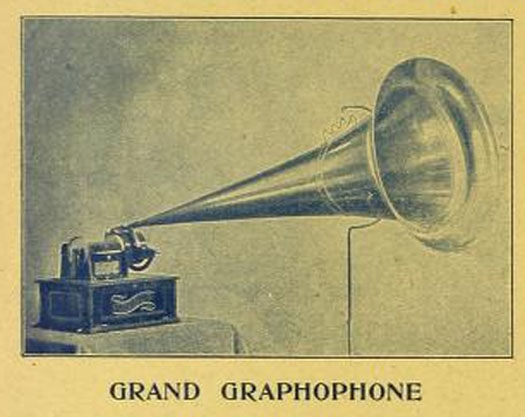
"The Graphophone
Grand - The Greatest Improvement in Talking Machines in the
20 Years,"
The Phonoscope, December 1898.
Note: J. J. Fisher recorded for the
Columbia Phonograph Company and made the following record for Columbia
circa 1898.
LISTEN:
Savior pilot me. [Jesus,
savior, pilot me] - by. J. J. Fisher, Brown wax cylinder. Columbia
Phonograph Co.: 9123. Released between 1898 and 1900. (Source: UCSB
Cylinder Audio Archive, John Levin Collection.) Released between
1898 and 1900.
Fisher also recorded for Berliner,
Edison, Zonophone, Victor, Climax, Oxford, et al.
T. W. Searing
Another claim regarding
the First Engraving of Recorded Sound headlined "Claims
to be the First Inventor of the Talking Machine" was published
in a letter to The Phonoscope, published December 1898 from
T. W. Searing. As was the case in J. J. Fisher's "address"
made on behalf of the Columbia Phonograph Company, neither Bell
& Tainter or Searing are able to state that they invented the
first device which could record and playback those recorded
sounds. The engraving vs. indentation method of recording would
be heavily litigated and cross-patents would be implemented. But
it misses the point and should not be given parental rights for
the birth of the phonograph.
Additionally, if it
was simply the issue of recording sound waves of the human voice
on a medium that could later reproduce that voice then the role
of Édouard-Léon
Scott de Martinville also needs to be included.
For Friends of
the Phonograph, however, it is a FACTOLA that
all three conditions were met by Edison on December 6, 1877 to establish
the patrimony, delivery and birth of the first talking machine.
1) Kruesi finished the Phonograph
on December 6;
2) Edison spoke and then heard what
he later said were his "first words into the original phonograph,
a little piece of practical poetry: Mary had a Little Lamb"
on December 6;
3) Edison made the decision on December
6 that his Phonograph was finished and ready to talk to the world
which he would do the next day by taking the phonograph to the office
of Scientific American where the precocious phonograph would
introduce itself.
Happy Birthday to Edison's Phonograph
- December 6, 1877.

The
Phonoscope, December 1898.
Last Updated: December
6, 2023

Phonographia
|

